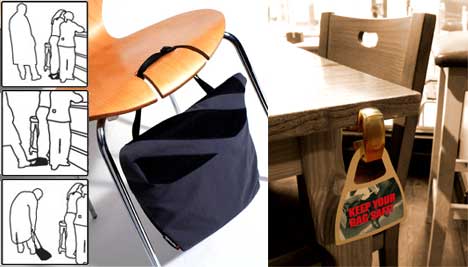19 Ene Design Against Crime for more Sustainablility

Last week I wrote about the Sweet Dream Security products and some of you didn?t agree with me that these should be considered sustainable design. Ok, those products could be made from eco-friendlier materials but what I?m interested in here is the role of the designer against crime. So let me tell you about the UK-based research centre Design Against Crime (DAC).
Contemporary concepts of using design to impact crime and fear of crime have been around since the sixties with writers and researchers like Jane Jacobs (The Life and Death of the Great American Cities) and later, Oscar Newman (Defensible Space).
The DAC Research Centre, headed by Prof. Lorraine Gamman, based at Central Saint Martins College of Art and Design in London, have taken the approach further and are benchmarking good practice as well as seeking to create new examples through design. They employ graphic design to map out different crimes and as an important tool to communicate and raise awareness. For example techniques for theft. But DAC also concept prove and test products. An example is the Grippa project initiated in 2004. The aim was to create ?anti bag theft furniture’ and ?anti bag theft furniture accessories’ for bar and restaurant environments and test those for effectiveness in reducing theft as well as avoiding forgotten or abandoned bags which leads to a safer and cleaner environment. Even though the objects created were tested in a UK restaurant chain and have attracted UK manufacturing interest, DAC are not so keen on mass-producing. Marcus Willcocks, DAC designer and researcher, told us ?it?s more about research and communication and about changing ideas than simply creating and selling more products.? DAC considers that customising existing furniture to fit each bar or restaurant?s style and environment can make more sense than getting them to throw out the old fittings for new ones.
Sometimes however, new furniture is needed. Foxed / Stop Thief is smart furniture that set out to ?maximise the value of the chair as a culturally recognised icon of the design industry, and to make chairs more secure by design?. Willcocks adds that the choice of material and production are important when it comes to designing products. So far, all the DAC produced products have been fabricated in the UK. For the DAC team, it?s Socially Responsive Design they aim for. For them, sustainable futures are about making streets safer -and making them feel that way; reducing the amount of police time needed to combat theft when there are bigger fish to catch or making cities bike-friendlier through improved parking and bike security. They promise us a great example opening this summer in London; the Bikeoff Holborn Gateway Project, run by Adam Thorpe. This is another site, context and user specific project to provide safer bike parking. If you?re curious, check out their web site for in depth research into bike theft, tips on how not to get your bike stolen and to share your feedback. ::Design Against Crime



Sorry, the comment form is closed at this time.